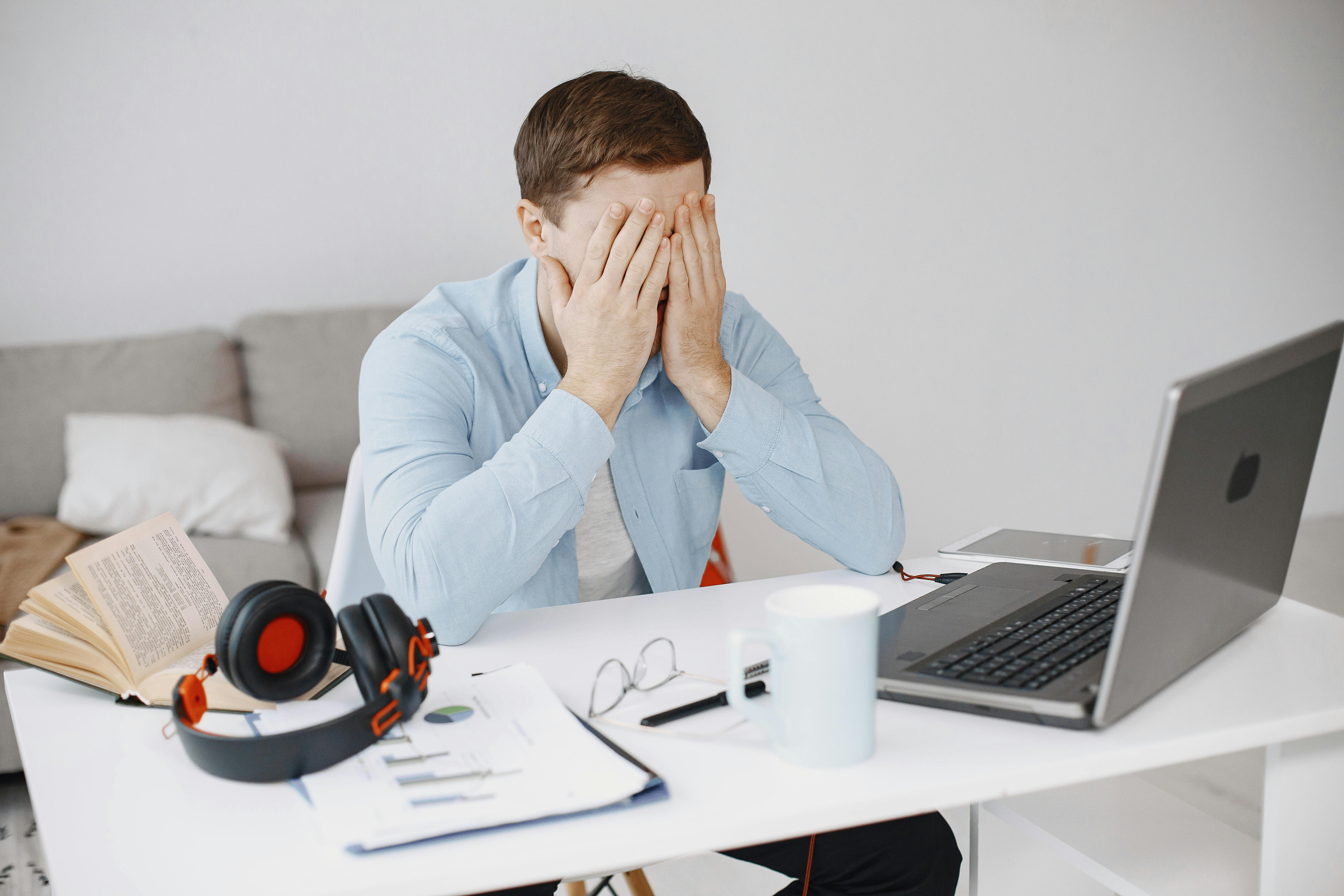
10 Simple Desk Setup Changes to Prevent Eye Fatigue
If you spend hours in front of a screen, you’ve probably felt it that dry, tired, or burning sensation creeping into your eyes by the end of the day. Maybe your vision feels a little blurry when you glance away from your monitor, or you’ve caught yourself rubbing your eyes between emails.
This isn’t just an inevitable part of working on a computer. It’s often a clear warning sign of Computer Vision Syndrome (CVS) — also called digital eye strain. And it’s becoming more common than ever, with research showing that more than 50% of regular screen users experience symptoms daily.
The cause isn’t just the screen itself — it’s often your desk setup. The height of your monitor, the lighting in your room, and even where you place your documents all quietly influence how hard your eyes have to work.
The good news? You don’t have to invest in an expensive ergonomic overhaul to feel the difference. By making just a few simple desk setup adjustments, you can:
-
Reduce eye fatigue and dryness
-
Improve focus and concentration
-
Prevent those afternoon headaches
-
Support better posture and overall comfort
In the next few minutes, you’ll learn 10 practical, science-backed changes you can start today to protect your eyes and boost productivity — without disrupting your workflow.
1. Adjust Monitor Height to Eye Level
Your monitor should sit so that the top of the screen is at or slightly below eye level. This keeps your head and neck in a neutral position and prevents you from looking up or down for extended periods.
Pro Tip: Use a monitor stand, adjustable arm, or even a stack of sturdy books to raise your screen to the right height.
2. Position Your Screen at the Right Distance
The ideal distance is about 20–28 inches from your eyes (roughly an arm’s length). Too close, and your eyes work harder to focus; too far, and you strain to see details.
Quick Test: Stretch your arm out — your fingertips should almost touch the screen.
3. Reduce Glare with Proper Lighting
Overhead fluorescent lighting, bright windows, or even shiny desk surfaces can create glare that strains your eyes.
-
Position your monitor perpendicular to windows.
-
Use blinds or curtains to control sunlight.
-
Choose soft, indirect desk lighting.
4. Use an Anti-Glare Screen Filter
If lighting adjustments aren’t enough, an anti-glare filter can help reduce reflections from your screen, making it easier to read text and view images without squinting.
5. Choose a Matte Monitor Finish
Monitors with a glossy finish can amplify glare, while matte screens diffuse light. If you’re buying a new monitor, consider a matte model for a more eye-friendly experience.
6. Optimize Text Size and Display Settings
Tiny text forces your eyes to work harder.
-
Increase font size in your system settings.
-
Adjust brightness to match the surrounding light.
-
Use high-contrast themes for better readability.
7. Add Blue Light Filtering Tools
Blue light from screens can disrupt your sleep cycle and cause eye fatigue.
-
Enable Night Shift or Blue Light Filter mode on your device.
-
Use software like f.lux for automatic adjustment.
-
Consider blue light blocking glasses.
8. Keep Reference Materials at Eye Level
If you constantly glance down at papers, your eyes and neck are doing extra work. Use a document holder next to your monitor so your eyes stay at a consistent level.
9. Maintain a Clutter-Free Desk
A tidy workspace isn’t just for productivity — it reduces visual distractions that make your eyes dart around unnecessarily. Keep your desk clean, with only the essentials in view.
10. Follow the 20-20-20 Rule with a Desk Timer
Every 20 minutes, look at something 20 feet away for 20 seconds. This simple habit relaxes your eye muscles and reduces strain over time.
Additional Tips for Reducing Eye Strain While Working
1. Blink More Often to Prevent Dryness
When you’re focused on a screen, your blink rate can drop by as much as 50%. Fewer blinks mean your eyes don’t get the constant layer of moisture they need, leading to dryness, irritation, and even redness. Make a conscious effort to blink fully and regularly — or try “20 conscious blinks” every hour to refresh your eyes.
2. Stay Hydrated to Support Tear Production
Your eyes rely on healthy tear film to stay comfortable, and that starts with staying hydrated. Aim for steady water intake throughout the day instead of gulping down large amounts all at once. Herbal teas, fruits with high water content (like cucumber or watermelon), and even a desktop water bottle can make hydration an easy habit.
3. Take Short Breaks to Walk Around and Stretch
Your eyes and your body work as a team. Every 30–60 minutes, take a brief pause from your screen — stand up, walk to the other side of the room, or stretch your shoulders and neck. This helps reduce muscle tension, improves blood flow, and gives your eyes a chance to reset focus.
FAQs About Desk Setup for Eye Strain
1. What is Computer Vision Syndrome and how is it different from normal eye tiredness?
Answer: Computer Vision Syndrome (CVS) — also called digital eye strain — is a collection of vision and eye-related problems caused by prolonged screen use. While normal eye tiredness might happen after an unusually long day or lack of sleep, CVS is directly linked to factors like poor monitor placement, improper lighting, small text sizes, or insufficient breaks. Symptoms include dryness, burning, blurred vision, headaches, and even neck or shoulder pain. The difference is that CVS is recurring and tends to get worse without targeted changes to your workspace and screen habits.
2. How far should my monitor be from my eyes to prevent strain?
Answer: The ideal monitor distance is roughly 20–28 inches (about an arm’s length) from your eyes. If it’s too close, your eyes constantly work harder to focus; too far, and you start squinting. An easy test: stretch your arm straight out — your fingertips should just about touch the screen. If you work with multiple monitors, keep your primary one directly in front of you at this distance and angle the others slightly inward to reduce head movement.
3. Can changing my desk lighting really help with eye fatigue?
Answer: Absolutely. Poor lighting is one of the biggest contributors to glare, which forces your eyes to work harder. Bright overhead lights, direct sunlight, or even reflections from glossy desk surfaces can all increase strain. For an eye-friendly setup:
-
Position your screen perpendicular to windows to avoid glare.
-
Use adjustable blinds or curtains to control natural light.
-
Opt for soft, indirect desk lighting instead of harsh overhead fixtures.
-
Consider a lamp with a warm LED bulb, which reduces harsh contrast.
4. Are blue light filters or glasses worth it?
Answer: Blue light from screens isn’t harmful in the short term, but it can disrupt your circadian rhythm and contribute to fatigue during extended use. Blue light filters — either built into your device (Night Shift, Eye Saver Mode) or as physical screen protectors — can reduce exposure, especially in the evening. Blue light blocking glasses can help if you work in multiple digital environments or if your device lacks effective filter settings. While they’re not a complete solution, they can complement good desk ergonomics and healthy screen habits.
5. How often should I take breaks from my screen?
Answer: Eye care specialists recommend the 20-20-20 rule: every 20 minutes, look at something 20 feet away for at least 20 seconds. This gives your eye muscles a chance to relax and refocus. You can set a small timer on your desk or use free break reminder apps to make it a habit. For even better results, combine this with standing, stretching, and a quick sip of water — your eyes, back, and brain will thank you.
Conclusion: Protect Your Eyes, Boost Your Productivity
A few small desk setup changes can truly transform how your eyes feel at the end of the day. By fine-tuning your monitor position, reducing glare, and adopting simple visual habits like the 20-20-20 rule, you’re not just preventing eye fatigue — you’re investing in your long-term vision health.
Think of your eyes as your most important work tool. Every email you send, design you create, or spreadsheet you analyze depends on them. Treat them well, and they’ll reward you with clearer focus, better comfort, and more productive days.
So before you dive back into your next task, take a few minutes to adjust your workspace. Your eyes and your future self will thank you.

Dr. Emily Carter OD
Optometrist & Workplace Vision Specialist
Board-certified optometrist with 15+ years of experience in digital eye strain prevention, dry eye care, and workplace ergonomics.
Passionate about helping people protect their vision in the digital age.